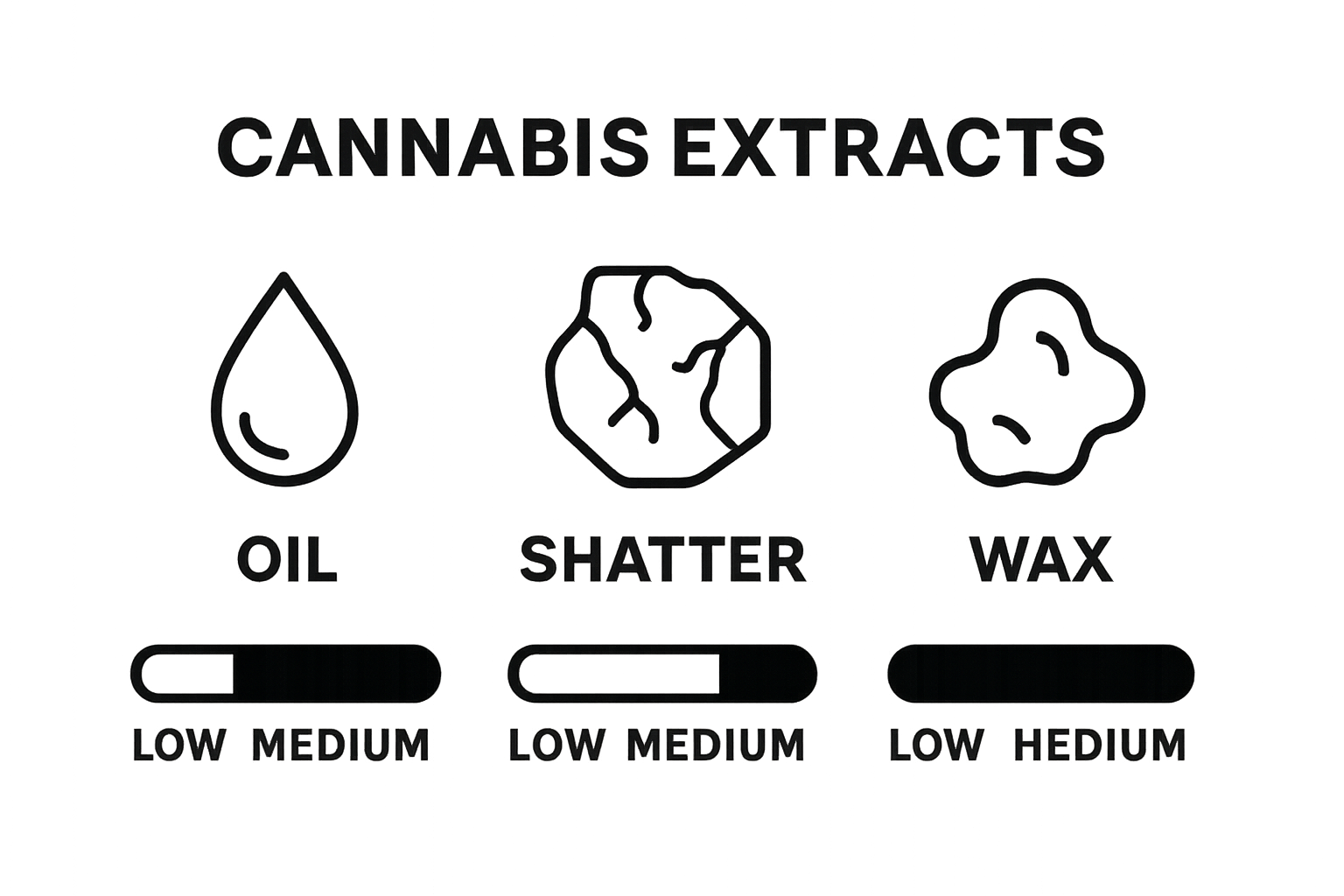Blog
Understanding What Are Cannabis Extract Types
Cannabis extracts are changing what people expect from both medical treatments and recreational experiences. Some of these products pack a punch with THC concentrations reaching up to 90 percent, far outpacing the usual 10 to 25 percent found in regular cannabis flower. Most imagine extracts simply as stronger versions of what grows in nature, but the reality goes much deeper. These concentrated forms are unlocking uses and effects never even possible with traditional cannabis, surprising both researchers and everyday users.
Table of Contents
- What Are Cannabis Extract Types And Their Significance?
- Key Components Of Cannabis Extracts: Cannabinoids And Terpenes
- Exploring Different Cannabis Extract Forms And Their Features
- Comparing Extract Types: Uses, Benefits, And Effects
- Real-World Applications Of Cannabis Extracts In Medicine And Recreation
Quick Summary
| Takeaway | Explanation |
|---|---|
| Cannabis extracts are highly potent. | These extracts can contain 50-90% THC, significantly higher than raw cannabis flower, allowing more intense effects. |
| Terpenes enhance cannabis effects. | Aromatic compounds called terpenes influence mood and experience, contributing to the unique benefits of each extract. |
| Different extraction methods yield unique products. | Extraction techniques, such as CO2 or solventless methods, lead to diverse products like shatter, wax, and hash, each with distinct characteristics. |
| Controlled dosing benefits medical users. | Extracts enable more precise dosing which is crucial for patients seeking targeted treatment for conditions like pain or inflammation. |
| Recreational extracts offer personalized experiences. | The variety of cannabinoid and terpene profiles allows consumers to select extracts tailored to specific mood or social goals. |
What Are Cannabis Extract Types and Their Significance?
Cannabis extracts represent concentrated forms of the plant’s most potent compounds, designed to provide enhanced therapeutic and recreational experiences. These advanced products isolate and concentrate cannabinoids like THC and CBD through specialized extraction techniques, transforming traditional cannabis consumption methods.
Understanding Cannabis Extract Fundamentals
Cannabis extracts differ from traditional plant materials by offering substantially higher cannabinoid concentrations. While raw cannabis flower typically contains 10-25% THC, extracts can reach potency levels between 50-90%, delivering more intense and targeted effects. Research from the National Center for Biotechnology Information highlights that these concentrated forms have gained significant popularity due to their efficient compound delivery.
Key characteristics of cannabis extracts include:
- Higher cannabinoid concentration compared to traditional flower
- Precise extraction methods preserving specific plant compounds
- Versatile consumption options including vaping, dabbing, and oral ingestion
- Enhanced potential for medicinal and recreational applications
Classification and Extraction Methods
Extract types are primarily distinguished by their production method and resulting chemical composition. Solvent-based extractions like butane hash oil (BHO) and CO2 extractions create different product profiles, each with unique characteristics. Solventless methods such as rosin pressing provide alternative options for consumers seeking pure, chemically untreated concentrates.
The significance of cannabis extracts extends beyond potency. These concentrated forms allow for more controlled dosing, targeted therapeutic interventions, and a broader range of consumption experiences. Medical patients can leverage specific extract types to address particular symptoms, while recreational users can explore nuanced effects and flavor profiles unavailable in traditional cannabis consumption methods.
Understanding cannabis extracts requires recognizing their complexity as sophisticated botanical products that represent the cutting edge of cannabis science and consumer technology.
Key Components of Cannabis Extracts: Cannabinoids and Terpenes
Cannabis extracts are complex botanical compositions defined by two primary molecular groups: cannabinoids and terpenes. These microscopic compounds determine the extract’s therapeutic potential, sensory experience, and overall biochemical interaction with the human body.
Understanding Cannabinoids
Cannabinoids are specialized chemical compounds unique to cannabis plants, with over 100 different variations identified by scientific research. The two most prominent cannabinoids are tetrahydrocannabinol (THC) and cannabidiol (CBD). Research from the National Institutes of Health demonstrates these compounds interact directly with the human endocannabinoid system, influencing neurological and physiological processes.
Key characteristics of cannabinoids include:
- Direct interaction with human receptor systems
- Potential therapeutic applications across multiple medical domains
- Variability in psychoactive and non-psychoactive properties
- Unique molecular structures determining specific biological effects
Terpenes: The Aromatic Molecular Architects
Terpenes are aromatic organic compounds responsible for the distinctive scents and flavors in cannabis extracts. Beyond sensory experiences, terpenes play a crucial role in modulating cannabinoid effects through a phenomenon known as the “entourage effect.” These molecular compounds contribute to the extract’s overall therapeutic potential by enhancing or mitigating cannabinoid interactions.
Terpenes represent more than just aromatic molecules. They function as sophisticated biochemical modulators that can influence mood, stress response, and physiological processes. Their complexity extends far beyond simple fragrance, positioning them as critical components in understanding cannabis extract efficacy and experience.
The intricate relationship between cannabinoids and terpenes underscores the sophisticated nature of cannabis extracts.
This table organizes the key components found in cannabis extracts, briefly defining their roles and contributions to the overall effects and uses of these products.
| Component | Description | Role in Extracts |
|---|---|---|
| THC | Primary psychoactive cannabinoid | Produces euphoric and intense effects |
| CBD | Non-psychoactive cannabinoid | Offers therapeutic benefits without a high |
| Other Cannabinoids | Over 100 minor cannabinoids present | Modulate various physiological responses |
| Terpenes | Aromatic organic molecules | Influence flavor, aroma, and effect synergy |
These molecular interactions represent a dynamic biochemical landscape that continues to fascinate researchers and consumers alike, highlighting cannabis as a complex botanical with profound potential for therapeutic and experiential applications.
Exploring Different Cannabis Extract Forms and Their Features
Cannabis extracts come in diverse forms, each presenting unique characteristics, potency levels, and consumption methods. These sophisticated products represent advanced techniques for concentrating and delivering cannabis compounds, transforming traditional consumption experiences.
Liquid and Semi-Solid Extract Varieties
Liquid and semi-solid cannabis extracts offer versatile consumption options with varying consistency and potency. Research from cannabis extraction studies reveals that these extract forms can range dramatically in THC concentration, from 10% to over 90%, depending on extraction techniques.
Key liquid and semi-solid extract types include:

- Hash oil (cannabis oil)
- Shatter (glass-like, translucent extract)
- Wax (soft, opaque concentrate)
- Honeycomb wax (brittle, porous texture)
Solid Extract Formats
Solid cannabis extracts represent more compressed and concentrated forms of cannabis compounds. Hashish, a traditional solid extract, exemplifies this category with its unique production method involving trichome collection and compression. These formats offer distinct advantages in portability, storage, and precise dosing.
Solid extract characteristics include:
- Compressed resin from cannabis trichomes
- Varying color ranges from light to dark brown
- Potential THC concentrations up to 65%
- Compact and easily transportable
The evolution of cannabis extracts demonstrates remarkable scientific innovation. Each extract form reflects sophisticated botanical processing, enabling consumers to experience cannabis compounds with unprecedented precision and control. From liquid oils to solid hashish, these products represent a technological advancement in botanical compound delivery.
Below is a comparison table summarizing the main types of cannabis extract forms, highlighting their composition, THC concentration range, and typical consumption methods.
| Extract Form | Physical State | Approx. THC Concentration | Typical Consumption Methods |
|---|---|---|---|
| Hash Oil | Liquid | 10% – 90% | Vaping, ingestion, dabbing |
| Shatter | Semi-solid | 50% – 90% | Dabbing, vaping |
| Wax | Semi-solid | 50% – 90% | Dabbing, vaping |
| Honeycomb Wax | Semi-solid | 50% – 90% | Dabbing, vaping |
| Hashish | Solid | Up to 65% | Smoking, ingestion |

Comparing Extract Types: Uses, Benefits, and Effects
Cannabis extracts offer diverse applications across therapeutic, recreational, and wellness domains. Understanding the nuanced differences between extract types enables consumers to select products aligned with their specific needs and desired experiences.
Therapeutic Applications and Medical Potential
Medical cannabis extracts represent a sophisticated approach to targeted symptom management. Research investigating full-spectrum cannabis extracts demonstrates significant potential in addressing complex medical conditions, particularly in pain management and inflammation reduction.
Key therapeutic extract characteristics include:
- Potential analgesic properties
- Capability to modulate inflammatory responses
- Synergistic interactions with human endocannabinoid systems
- Variability in cannabinoid concentration affecting therapeutic outcomes
Recreational and Wellness Effects
Recreational cannabis extracts provide nuanced experiences distinguished by their specific cannabinoid and terpene profiles. Different extracts produce varied effects ranging from relaxation and stress reduction to enhanced sensory perception and mood elevation. The concentration of THC and presence of complementary compounds determine the extract’s overall experiential profile.
Important considerations for recreational extract selection involve understanding individual tolerance, desired effects, and potential physiological responses. Consumers must approach extract consumption with informed decision making, recognizing the potent nature of concentrated cannabis products.
The comparative landscape of cannabis extracts reveals a complex botanical ecosystem. Each extract type represents a unique molecular configuration, offering distinct pathways for therapeutic intervention and personal exploration. This diversity underscores cannabis’s remarkable potential as a multifaceted botanical substance with profound implications for human wellness and experience.
Real-World Applications of Cannabis Extracts in Medicine and Recreation
Cannabis extracts have transcended traditional boundaries, emerging as sophisticated tools for medical intervention and personal wellness. Their versatility spans therapeutic treatments, recreational experiences, and holistic health approaches, reflecting a complex botanical resource with multifaceted potential.
Medical Treatment Innovations
Research from the National Institute on Drug Abuse highlights cannabis extracts as powerful therapeutic agents addressing numerous medical conditions. These concentrated botanical compounds demonstrate remarkable potential in managing complex health challenges through targeted molecular interactions.
Key medical applications include:
- Neurological disorder management
- Chronic pain mitigation
- Reduction of inflammatory responses
- Potential neuroprotective interventions
- Symptom management for multiple sclerosis
Recreational and Wellness Experiences
Recreational cannabis extracts offer nuanced experiences beyond traditional consumption methods. These sophisticated products enable precise control over dosage, effects, and sensory experiences. Users can select extracts tailored to specific mood enhancement, relaxation, or social interaction goals.
Important considerations for recreational use involve understanding individual physiological responses, extract potency, and responsible consumption practices. The diverse range of extracts allows for personalized experiences that extend far beyond conventional perceptions of cannabis use.
The convergence of medical research and consumer innovation continues to expand our understanding of cannabis extracts. These complex botanical compounds represent more than mere substances they are sophisticated tools for exploring human physiological and experiential potential, bridging scientific research with personal wellness strategies.
Elevate Your Cannabis Extract Experience with Puff Laco
Are you searching for a trustworthy source to explore the full power of cannabis extracts described in this article? You know that understanding the difference between extracts such as full spectrum, live resin, and various concentrate types is essential, especially when it comes to potency, purity, and consistency. Too many consumers struggle to find authentic products that align with their quality expectations and specific therapeutic or recreational goals. If you feel unsure about where to begin or worry about safety and product verification, you deserve a resource that is as dedicated to reliability as you are to better results.
Puff Laco delivers the advantages you’re seeking:
- Premium, lab-tested vapes, disposables, and edibles made from full spectrum and live resin extracts
- Products that are 100 percent verified and backed by strict pesticide, purity, and potency testing
- Easy guides and real feedback so you can select the right extract type for your lifestyle
.png)
Ready to unlock the benefits of pure, potent, and authentic cannabis extracts? Visit Puff Laco now to browse a trusted selection of vapes, pre-rolls, and gummies crafted for both wellness and enjoyment. Take control of your journey with fast shipping and exclusive offers waiting for you today.
Frequently Asked Questions
What are cannabis extracts?
Cannabis extracts are concentrated forms of the cannabis plant that isolate and concentrate cannabinoids like THC and CBD. They offer higher potency than traditional cannabis flower and are designed for therapeutic and recreational use.
How are cannabis extracts made?
Cannabis extracts are produced through various extraction methods, including solvent-based methods (like butane hash oil and CO2) and solventless methods (like rosin pressing). Each method produces different product profiles with unique characteristics.
What are the benefits of using cannabis extracts?
Cannabis extracts provide enhanced potency, precise dosing, and targeted effects for both medicinal and recreational users. They can help manage specific symptoms for medical patients and offer varied experiences for recreational users based on different cannabinoid and terpene profiles.
What are the different forms of cannabis extracts available?
Cannabis extracts come in various forms, including liquid and semi-solid options like hash oil and wax, as well as solid formats like hashish. Each form has distinct characteristics and potency levels, allowing for versatile consumption methods.
Recommended
- 7 Terpene Types Explained: Unlocking Cannabis Aromas – PUFF LA
- Understanding Flavor Profiles in Cannabis – PUFF LA
- 8 Unique Cannabis Flavor Profiles List to Enhance Your Experience – PUFF LA
- Understanding What Are Flavor-Specific Strains – PUFF LA

